 Society
Society
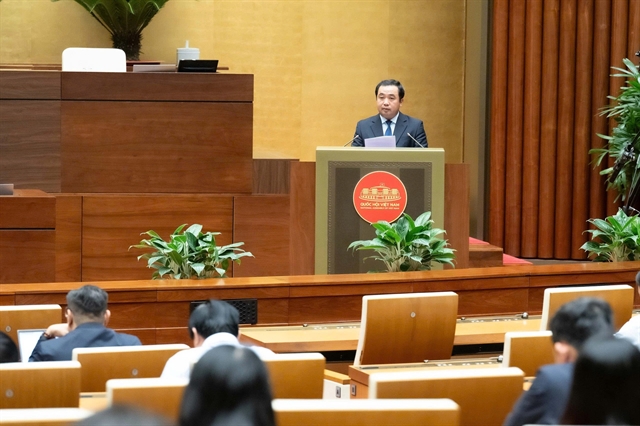
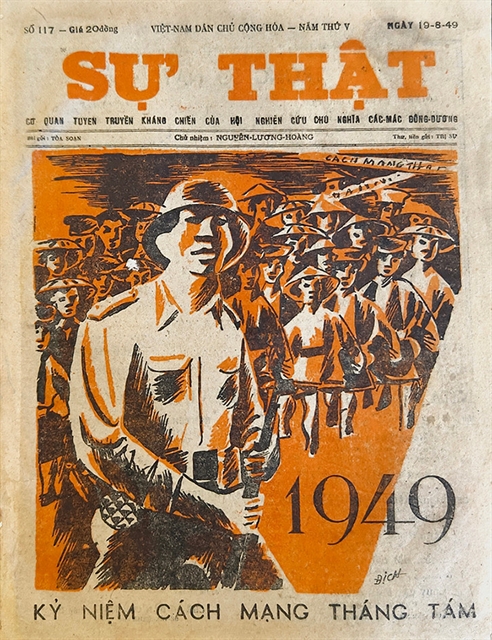 |
| Front page of Sự Thật (Truth) newspaper, published on August 19, 1949, commemorating the anniversary of the August Revolution. Sự Thật was the predecessor of today's Nhân Dân (People) newspaper. VNS Photos Nguyễn Khánh Chi |
Nguyễn Khánh Chi
HÀ NỘI — As Việt Nam prepares for the grand celebrations of the August Revolution and National Day, Nguyễn Phi Dũng finds himself quietly turning back time.
From his collection, he retrieves a yellowed copy of Độc Lập (Independence) newspaper, issued on September 5, 1946, its front page still echoing with the pride and promise of the nation’s first National Day.
"On the morning of September 2, 1946, Việt Nam’s first grand military parade marched through Chí Linh Flower Garden [today known as Lý Thái Tổ Flower Garden]. From early dawn, tens of thousands gathered around Hoàn Kiếm Lake, a forest of flags and banners," reads the article, titled 'Independence Day in the Capital - The First Great Military Parade of Việt Nam'.
Today, this A3-sized newspaper, tinged with the colours of time, is meticulously preserved within the extensive collection of Dũng, a private collector in Nam Định City, now Ninh Bình Province, whose archives weigh over 20 tonnes.
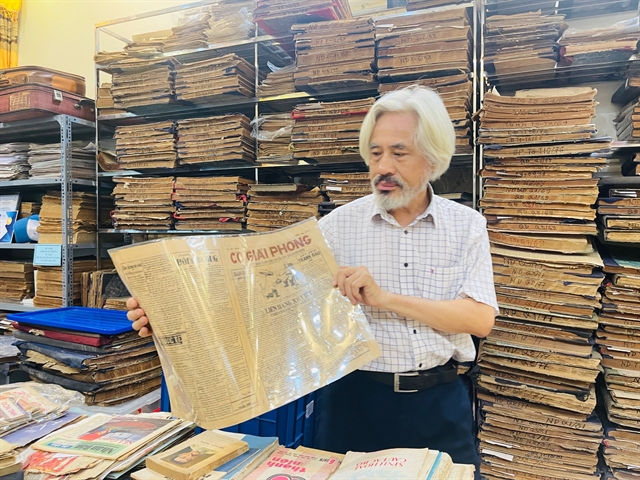 |
| Nguyễn Phi Dũng and the first issue of 'Cờ Giải Phóng' (Liberation Flag) newspaper. |
Living witnesses to history
The story traces back to his father’s love of newspapers. In the 1970s and 1980s, he would buy them regularly, then carefully bind and store them in thick volumes.
Dũng, however, noticed that over the years, the stack of volumes grew thinner and thinner. He once asked his father why, only to learn that his father had run out of money for new issues and had to sell the old ones.
“That answer stirred something in me. I began looking for the very papers he used to read, to keep alive the habit he had cherished,” said Dũng.
“What started as a simple wish gradually became a passion. The more I collected, the more I realised that printed newspapers are like living witnesses to history, preserving the stories of their time, their culture and the everyday lives of people. They are treasures for the generations to come."
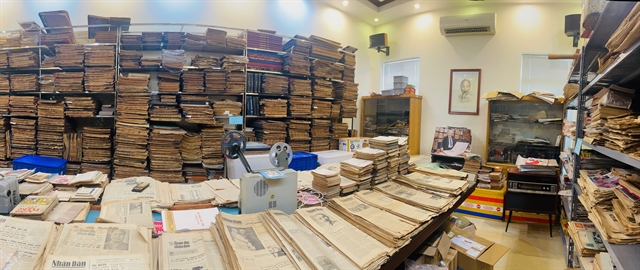 |
| A corner of Nguyễn Phi Dũng's collection of print newspapers. |
In 2016, after finishing the building that now serves as both his company headquarters and home, Dũng began collecting in earnest.
Today, most information is concentrated in online newspapers, television and social media, where speed and immediacy matter most. Yet Dũng believes printed newspapers still hold a special value.
"First, once a newspaper has gone to print, it cannot be edited or retracted, placing a much greater responsibility on journalists. Second, unlike books or novels, newspapers are almost never reprinted," said the 64-year-old businessman.
"For me, holding an old newspaper always stirs powerful emotions and nostalgia, as if I am reliving the past through its pages."
According to Dũng, in collecting newspapers, finding the very first issue is always the hardest.
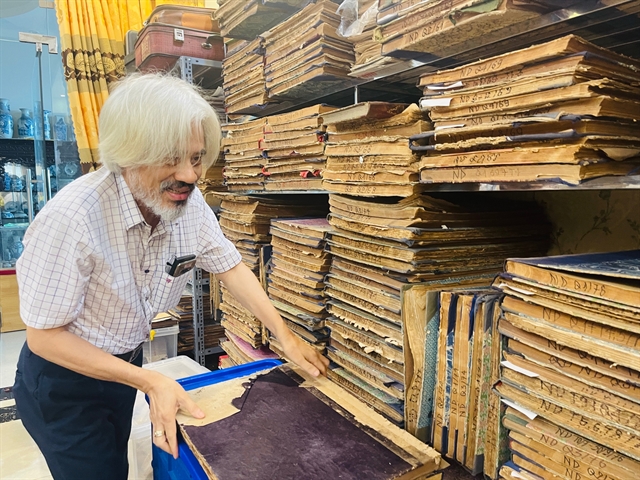 |
| Nguyễn Phi Dũng carefully preserves his collection. |
At present, he owns about 30 inaugural editions of Vietnamese newspapers, spanning from the earliest publications to revolutionary press titles such as Gia Định Báo, Cứu Quốc, Độc Lập and Cờ Giải Phóng. Among them, Cờ Giải Phóng, the official organ of the Indochinese Communist Party, published on October 10, 1942, is the only surviving copy in the entire country. He acquired it three years ago for VNĐ50 million (nearly US$1,900), along with several other southern newspapers from before 1975.
He was determined to collect this particular paper because it is the only known copy in Việt Nam to date. He had to make three trips before the owner finally agreed to part with it. He also believes that if he hadn’t collected it, no one in Việt Nam would know what the paper even looked like.
"The oldest newspaper in my collection is Le Courrier d’Haiphong (Hải Phòng News), a French-language publication released in 1886. I also deeply treasure my copy of Gia Định Báo, the very first Vietnamese-language newspaper, published in 1865 in Sài Gòn (now HCM City)," said Dũng.
"Just before last Lunar New Year, I acquired a copy of the Nhân Dân (People) newspaper, which included its inaugural issue dated March 11, 1951. Though not in perfect condition, the newspaper holds immense value for me."
"What brings me the greatest joy is that my newspaper collection has become a valuable historical resource for the community," Dũng added.
Many agencies and organisations, knowing about his collection, often contact him for assistance when facing difficulties finding archival images and documents related to history, especially during important anniversaries.
"Since my archive is categorised by historical periods, locating specific materials is quite easy. I usually provide scans or even donate the original items," said Dũng.
"Last year, when Nam Định celebrated the 60th anniversary of President Hồ Chí Minh's visit to the locality, I lent 37 artefacts to the local museum for their exhibition. These included many rare newspaper articles, vinyl records of President Hồ Chí Minh's speeches and several books published in the 1940s and 1950s."
He works in the field of information technology, which gives him a great advantage in navigating the internet. Through platforms like Facebook, Zalo and various websites, he has connected with many people who share his passion and have helped him access more sources.
Once, he acquired a batch of Nhân Dân newspapers weighing about a tonne, which he personally transported from HCM City by train. Most of his collecting trips, however, are to northern provinces like Hà Nội and Bắc Ninh.
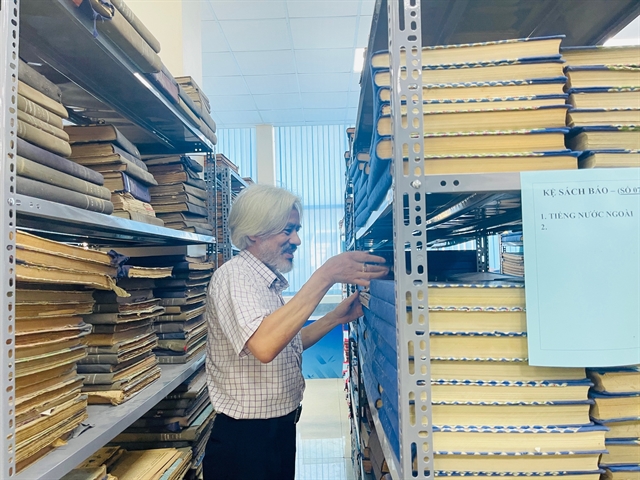 |
| Dũng's archive is categorised by historical periods, so locating specific materials is quite easy. |
Record-making
On November 29, 2024, the Vietnam Records Organisation awarded a certificate of record to Dũng for having the largest collection of newspapers published in Việt Nam from the late 19th century until now.
To date, he has collected approximately 400,000 newspaper issues from over 1,000 different titles, with a total weight of 21 tonnes. Of these, more than 100 titles were published in Việt Nam before 1954.
The preservation process is quite challenging. Newspapers are made from pulp, a material that is not as durable as metal or ceramics. There are risks related to termites, temperature and humidity.
Preserving these newspapers to this day has been extremely difficult, said Dũng, adding that he believes measures are needed for conservation, including digitisation, to mitigate future risks.
The idea to digitise his archives first came a few years ago, but a collection this large is too much for an individual to handle, he said. Fortunately, one of Dũng's friends from high school, Nguyễn Thành Nam, works at FPT and offered to sponsor the project earlier this year.
Nam found a reliable company, NTQ Software, for the project.
NTQ Software has over 1,000 employees and experts working on software in many different countries. Since March, the first phase of the project, which involved testing and finding basic equipment, has been largely completed. — VNS




